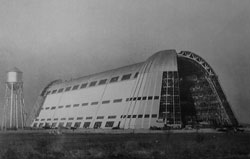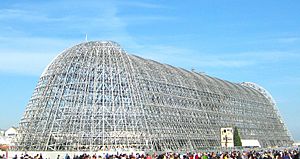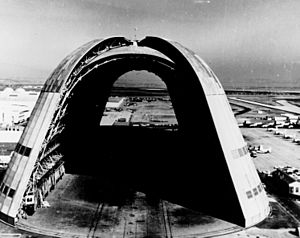Hangar One (Moffett Federal Airfield) facts for kids
Quick facts for kids |
|
|
Hangar One
|
|
|
U.S. Historic district
Contributing property |
|
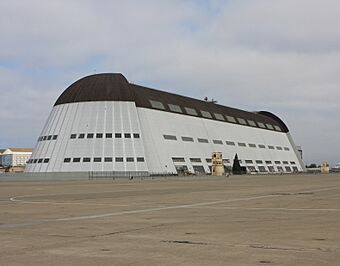
The hangar in 2009, before its old covering was removed.
|
|
| Location | Santa Clara County, near Mountain View and Sunnyvale, California, USA |
|---|---|
| Area | 8 acres (32,000 m2) |
| Built | 1933 |
| Architect | Dr. Karl Arnstein and Wilbur Watson Associates Architects and Engineers |
| Part of | US Naval Air Station Sunnyvale, California, Historic District (ID94000045) |
| Designated CP | February 24, 1994 |
Hangar One is a gigantic building at Moffett Field in California. It is one of the largest freestanding structures in the world, meaning it has a huge open space inside with no support columns. The hangar covers 8 acres, which is big enough to fit six football fields inside!
For many years, this massive building has been a famous landmark in Silicon Valley. It was built in the 1930s to be a home for the U.S. Navy's giant airship, the USS Macon. Today, it is part of the NASA Ames Research Center.
Contents
Building a Giant Hangar
Hangar One was designed by Dr. Karl Arnstein, an expert in airships and engineering. The building has a strong steel frame covered with galvanized steel panels. This whole structure sits on a solid concrete base.
The hangar is incredibly long and wide, measuring 1,133 feet (345 m) long and 308 feet (94 m) wide. Its curved shape helps it stand strong against the wind. The building is so tall, at 198 feet (60 m) high, that fog can sometimes form inside near the ceiling!
The Famous "Orange Peel" Doors
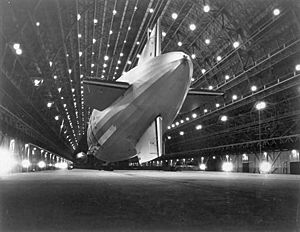
One of the hangar's most amazing features is its huge doors. They are shaped like clam shells, or "orange peels," and weigh 200 short tons (180 metric tons) each. These doors were specially designed to prevent strong winds from causing problems when the Macon airship was moved in or out. Each door has its own powerful motor to open and close it.
Inside the hangar, there were train tracks running from one end to the other. These tracks helped move the giant airships safely into the hangar or out to the field for flight.
History of Hangar One
Hangar One was built to serve the U.S. Navy's lighter-than-air craft, like blimps and dirigibles. Its main purpose was to house the USS Macon, one of the largest airships ever built.
Over the years, the hangar became a historic landmark. In 1994, it was added to the National Register of Historic Places, a list of important places in American history.
Saving a Landmark
In 2003, a problem was discovered. The hangar's outer panels were covered in old paint and materials that contained harmful chemicals. These chemicals were leaking into the ground and nearby water. This put the historic building at risk of being torn down.
Many people in the community wanted to save Hangar One. They saw it as an important part of their local history. After much discussion, a plan was made to clean up the site and restore the building.
In 2011, a huge project began to carefully remove all the old, toxic panels from the hangar's steel frame. This left only the building's skeleton standing.
A New Beginning with Google
Around the same time, the founders of Google offered to pay for the full restoration of Hangar One. In 2014, a company connected to Google, called Planetary Ventures, signed a 60-year lease to take care of the hangar and the airfield.
Google began the massive job of restoring the hangar. This included cleaning the structure and putting on a new, safe outer skin. The restoration work was completed in 2025, bringing the iconic landmark back to its former glory for future generations to see.
See also





